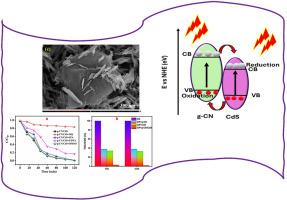片上g-C3N4/CdS混合纳米结构增强工业废水光催化解毒
IF 4.6
3区 工程技术
Q2 ENGINEERING, ELECTRICAL & ELECTRONIC
引用次数: 0
摘要
开发高性能、可持续的光催化剂对于减轻环境污染,特别是染料污染工业废水的处理至关重要。在这项研究中,我们报告了通过简单的水热方法合成石墨化碳/硫化镉(g-CN/CdS)复合材料,旨在提高可见光驱动的光催化效率和长期稳定性。综合的结构和化学表征,包括x射线衍射(XRD)和傅里叶变换红外(FT-IR)光谱,证实了CdS纳米颗粒成功锚定在g-CN基体上。光催化性能评价表明,g-CN/CdS复合材料对刚果红(CR)染料的降解率明显高于其单独的对应物,在可见光照射下达到99.85%的特殊降解效率。优异的活性主要归因于g-CN和CdS之间的协同耦合,促进了有效的载流子分离,抑制了电子-空穴复合,并减轻了光腐蚀。这项工作强调了异质结工程在优化光催化材料中的重要性,并为设计下一代纳米复合材料提供了一条可行的途径,用于环保和可扩展的废水修复技术。本文章由计算机程序翻译,如有差异,请以英文原文为准。

Rod-on-sheet g-C3N4/CdS hybrid nanostructure for enhanced photocatalytic detoxification of industrial effluents
The development of high-performance and sustainable photocatalysts is pivotal for mitigating environmental pollution, particularly in the treatment of dye-contaminated industrial wastewater. In this study, we report the synthesis of a graphitic carbon nitride/cadmium sulfide (g-CN/CdS) composite via a facile hydrothermal method, aimed at enhancing visible-light-driven photocatalytic efficiency and long-term stability. Comprehensive structural and chemical characterizations, including X-ray diffraction (XRD) and Fourier-transform infrared (FT-IR) spectroscopy, confirm the successful anchoring of CdS nanoparticles onto the g-CN matrix. Photocatalytic performance evaluations reveal that the g-CN/CdS composite exhibits a significantly higher degradation rate of Congo Red (CR) dye compared to its individual counterparts, achieving an exceptional degradation efficiency of 99.85 % under visible-light irradiation. The superior activity is primarily attributed to the synergistic coupling between g-CN and CdS, which facilitates efficient charge carrier separation, suppresses electron–hole recombination, and mitigates photocorrosion. This work underscores the importance of heterojunction engineering in optimizing photocatalytic materials and offers a viable pathway for designing next-generation nanocomposites for eco-friendly and scalable wastewater remediation technologies.
求助全文
通过发布文献求助,成功后即可免费获取论文全文。
去求助
来源期刊

Materials Science in Semiconductor Processing
工程技术-材料科学:综合
CiteScore
8.00
自引率
4.90%
发文量
780
审稿时长
42 days
期刊介绍:
Materials Science in Semiconductor Processing provides a unique forum for the discussion of novel processing, applications and theoretical studies of functional materials and devices for (opto)electronics, sensors, detectors, biotechnology and green energy.
Each issue will aim to provide a snapshot of current insights, new achievements, breakthroughs and future trends in such diverse fields as microelectronics, energy conversion and storage, communications, biotechnology, (photo)catalysis, nano- and thin-film technology, hybrid and composite materials, chemical processing, vapor-phase deposition, device fabrication, and modelling, which are the backbone of advanced semiconductor processing and applications.
Coverage will include: advanced lithography for submicron devices; etching and related topics; ion implantation; damage evolution and related issues; plasma and thermal CVD; rapid thermal processing; advanced metallization and interconnect schemes; thin dielectric layers, oxidation; sol-gel processing; chemical bath and (electro)chemical deposition; compound semiconductor processing; new non-oxide materials and their applications; (macro)molecular and hybrid materials; molecular dynamics, ab-initio methods, Monte Carlo, etc.; new materials and processes for discrete and integrated circuits; magnetic materials and spintronics; heterostructures and quantum devices; engineering of the electrical and optical properties of semiconductors; crystal growth mechanisms; reliability, defect density, intrinsic impurities and defects.
 求助内容:
求助内容: 应助结果提醒方式:
应助结果提醒方式:


